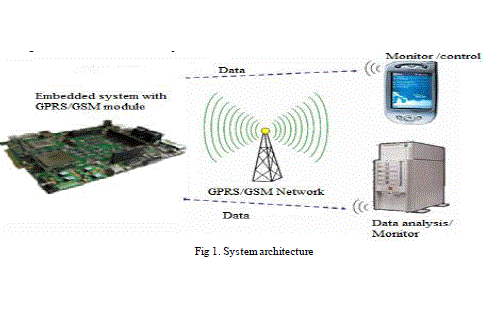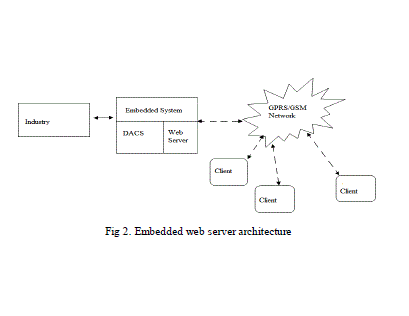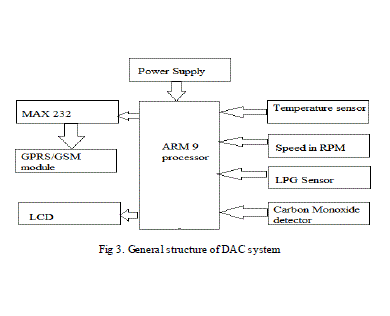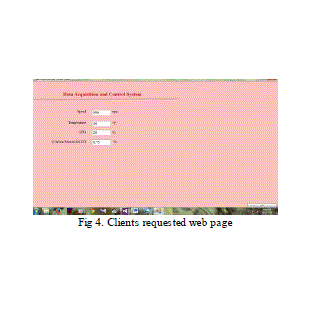ISSN ONLINE(2319-8753)PRINT(2347-6710)
ISSN ONLINE(2319-8753)PRINT(2347-6710)
Miss. Gayatri B. Kulkarni Prof. S. G. Joshi
|
| Related article at Pubmed, Scholar Google |
Visit for more related articles at International Journal of Innovative Research in Science, Engineering and Technology
Day by day the scope of networked embedded system is rapidly increasing for monitoring & controlling either home appliances or industry devices. Users can monitor & control remote machines/systems by using embedded web server. Idea is utilized for DAC by using Advanced RISC machine (ARM 9) processor & in-build web server application with General Packet Radio Service (GPRS) technology. GPRS technology along with GSM makes it accessible from anywhere in the world. This paper proposes low cost system development. Various sensors installed at working place help in sensing real time environmental conditioning like temperature, humidity, carbon monoxide etc
Keywords |
| GSM, GPRS, Real Time Processing, Embedded Web Server, DACs |
INTRODUCTION |
| Data acquisition & control plays an important role especially in military application, to study & monitor environmental changes in forests/oceans, surveillance application, home & industry automation. In this application, it is necessary to monitor & control of physical environments remotely with great accuracy & ease [1]. So data acquisition & control devices are best solution for unmanned devices in a multisite job operation. An acquisition unit design to collect data in their simplest form [2].which is based on Linux [3]; it is popular choice for many embedded PC systems. The similar system [4] will increases set up costs due to data accessed through central server. For wide range data transmission typical client-server architecture is not suitable because general purpose computer requires large space, large amount of memory & more cost. The central server can be removed by using web servers. This system still based on industrial PC [5]. An embedded web server creates an easy way for monitoring & controlling any device which is at remote place. Embedded network contains Advanced RISC machine i.e ARM 9 supports real time application also minimizes the system cost. This system detailed in Interactive DAC system [6]. Remote signals measure & can control through Ethernet module. This system should require PC with internet at the client side. We proposed a system which is portable, low cost & removes the need of server software & maintenance by using GPRS technology. It helps to communicate with GSM phone. Now a days GSM has in-built powerful TCP/IP protocol stack for internet data transfer over GPRS technology. Therefore the status of different sensors installed at working place can be monitor at anywhere in the world. Fig 1 shows the real time data acquisition over GPRS/GSM network. |
 |
| The structure of paper is as follows. Section II explains the concept. Section III will describe the operation when different sensors connected to the embedded system. In section IV describes testing of embedded web serve r. Section V presents the expected results. Finally section VI concludes paper & suggests some future work. |
EMBEDDED WEB SERVER ARCHITECTURE |
| General web servers, which are developed for general purpose computers like UNIX, LINUX or NT servers requires large megabyte of memory, a fast processor, pre-emptive multitasking & many more. An embedded web server provides remote access to devices from a web browser. Static & dynamic information about industry machineries & system provides same to the web browsers on request by an embedded web server. An embedded web server is integral part of embedded network [7], which consists of an ARM processor. ARM processor contains an internet software & application code for monitoring & controlling the systems. Embedded web servers have lot of advantages; user friendly, low cost, supports to real time application, low maintainability, portability, high reliability, security, controllability which general purpose computers can not give. Fig 2 shows proposed DAC system with embedded web sever. This contains a portable ARM 9 processor. This hardware built on a single chip module. An ARM processor is responsible for handling all tasks like measuring & conversion of signals, data base updating, communicating with owner by sending HTML pages. An ARM 9 processor manages all tasks in parallel in small amounts of time. |
 |
| The use of GPRS is familiar to all. Almost all GSM system providers give this service. So it is easy to be connecting to the internet world. After a GPRS connection has been established queried data can be relayed to the client via a central server [7]. Real-time system correctness depends not only on the correctness of the logical result of the computation but also on the result delivery time [8]. This method also increases the data transfer cost as the number of clients increases due to the access amount of data transfers via GPRS. Direct communication enables access to only relevant information in the embedded system by pre processing the data. The embedded system should also handle the web services. Using a central server to relay acquire data has some disadvantages. It needs a client interface framework. There is no direct bidirectional communication between client & embedded system. This system is unsuitable for real t ime applications. So it is necessary to eliminate the need of a central server & reduce the amount of data sent from the remote unit. In the proposed system, the GPRS architecture works with GSM protocols [9]. Because of GSM network, this system is configured to be virtually online at all t imes. After booting of the operating system an admin script is executed, initiating GPRS connection software module. A PPP connection is established by a GPRS modem that works at 900/1800/1900 MHz operating frequencies. A PPP daemon (PPPD) is used to manage the PPP network connections between the client and the embedded module. GPRS parameters such as the connection speed and compression are setting up by PPPD. The IP address of embedded devices should available at client side to directly access an embedded system. By using IP address people from remote location can access the information. There are two types of IP address i.e static IP & dynamic IP. Dynamic IP assigned through a Dynamic Host Configuration Protocol (DHCP) server of the GSM provider for every connection established. The DHCP approach is more flexible and works better compared with the static approach as a cost -effective solution, despite the necessity for a script running on the embedded server, one-time broadcasting its IP to the FTP server. The hypertext file placed on the FTP server by the embedded system and queried by the client. With this mechanism in place, the embedded system updates it IP information on the FTP server upon every reboot, which causes an IP refresh from the GSM serviceprovider. |
SYSTEM DESIGN |
| A. Data Acquisition System Fig 3 shows the general purpose DAC system which is at remote place. The remote I/O data acquisition and control system based on embedded ARM platform has high universality, each acquisition and control device equipped with 24- way acquisition/control channels and isolated from each other. Different types of sensors such as temperature sensor, motor, carbon monoxide detector, LPG gas leakage sensor are connected to each I/O channels of ARM processor. The data from sensors is collected & maintain by the ARM processor. The data is stored into the database. The GSM modem is serially interfaced with the controller with the help of MAX 232 [9]. GSM modem shares data from the board to internet. In Web Server mode, the data can be accessed by the client from anywhere acro ss the world through internet [9] |
 |
| B. Software The software coding is written in embedded C language in Keil software. The software consists of two major components. They are RTOS and HTML Pages. The application runs in the form of tasks. Tasks are created by each user connecting to the server. An RTOS is required to manage these tasks , which perform the operations in real time. The software running on the embedded web server follows the same layered structure as used in the TCP/IP protocol suite. The TCP/IP protocol suite allows computers of all sizes, running different operating systems, to communicate with each other. It forms the worldwide Internet called a Wide Area Network (WAN) of several million computers. The TCP/IP protocol suite is a combination of different protocols at various layers. Every layer acts independently from each other. The Internet Protocol (IP) delivers packets to Transmission Control Protocol (TCP), UDP, and Internet Control Message Protocol (ICMP), the ICMP answers to PING requests and TCP/UDP delivers data to the applications. The applications can communicate with the transport layer through buffers with data and variables with control information. There are six languages used for web design that have developed over the life time of World Wide Web. Generally web pages are designed using HTML or Hyper Text Markup Language. This language is interpreted by the browser like IE (Internet Explorer), Firefox and or Opera as well as other browser. HTML presented the user with a page of information. So here we also use HTML language to build embedded web pages. HTML pages are used for data communication between the client and the server. In the embedded web server, web pages are selected as the media of interaction. HTML is used in des igning these web pages. The HTML pages are saved on the board. |
TESTING OF EMBEDDED WEB SERVER |
| Firstly, the target is tested for the working of operating system. Booting of the target board is done by using the hyper terminal. This is done by booting the target board using the hyper terminal. After the target is successfully booted with RTOS, it is tested over the network using ping command [10]. Now the embedded web server is responding to the clients. A request is made to the embedded web server, by giving the IP address of the server. The user has to enter valid IP to access the server. The operating system manages the request of the client and gives to the LAN controller of the client system. The LAN controller sends the request to the router which processes and checks for the system connected to the network with that particular IP address. If the IP address entered matches to that of the server, a request is sent to the LAN controller of the server to the client and hence a session is established between server and the client and the server starts sending the web pages to the client [11]. |
| Firstly, the target is tested for the working of operating system. Booting of the target board is done by using the hyper terminal. This is done by booting the target board using the hyper terminal. After the target is successfully booted with RTOS, it is tested over the network using ping command [10]. Now the embedded web server is responding to the clients. A request is made to the embedded web server, by giving the IP address of the server. The user has to enter valid IP to access the server. The operating system manages the request of the client and gives to the LAN controller of the client system. The LAN controller sends the request to the router which processes and checks for the system connected to the network with that particular IP address. If the IP address entered matches to that of the server, a request is sent to the LAN controller of the server to the client and hence a session is established between server and the client and the server starts sending the web pages to the client [11]. |
RESULT |
| After requesting the web pages by the client, the online processing web page for client authentication is opened. Client has to enter valid user name & password to access the embedded web server data. These web pages are requested by the client and served by the embedded web server which is ported on ARM9 processor. Client can interact with the machine through its own browser via these embedded web pages. Every client’s control has been executed in industry via the embedded web server. The dynamic web page representing the sensor values in the Data Acquisition System maintained by the embedded web server is shown in fig. 4. The client access the data dynamically through this web page send by the server. This is the simplest way of accessing data by the client. Moreover more than one client can access the data at the same time from different parts of the world. |
 |
CONCLUSION |
| In this application, a low-cost, Internet-based data acquisition and control system has been designed and implemented that should find interest from researchers. The applicat ion possibilities are virtually unlimited by attaching modules with appropriate interfaces, although the usage of the system is demonstrated with only a few sample devices. Compared with other applications, this system has advantages in terms of allowing direct bidirectional communicat ion and reducing overhead, which can be vitally important for some real -time applications. The operational costs have been reduced by relinquishing the storage of large data to an FTP server on the Internet. The system is designed to support both static and dynamic IPs. A method to distribute the IP informat ion has been developed. This cost-minimizat ion effort is a big concern for mobile systems using wireless communication methods. The overall cost advantage of the system in terms of the components used makes it an attractive choice for data -acquisition applicat ions. This system can be widely applied to electric power, petroleum, chemical, metallurgy, steel, transportation, Electronic & Electrical industries, Automobiles and so on. The power demand of the device is still in the process of being improved by putting the attached devices into sleep mode at times when they are not in use to conserve power. Also the sending of video recording of control room is still in process. The availability of previous data on web server is also not discuss yet. |
ACKNOWLEDGMENT |
| I would like to thank Prof. Joshi S.G. , for her unending support and wisdom urged me to pursue new ideas to implement in my project. Moreover I would like to thank my teachers from VACOE, (E&TC) department for their support and guidance |
References |
|